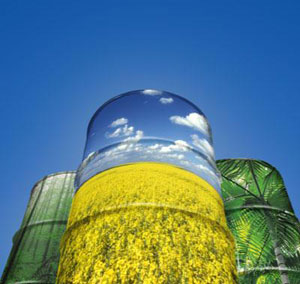Biodiesel is a biofuel which is produced from organic oils or fats, and can be used in diesel engines. The technical name for standard biodiesel is alkyl methyl ester. Generally, this is made from reacting vegetable oil and methanol using a catalyst, resulting in a molecule that contains hydrogen, carbon and oxygen. The presence of oxygen in the molecule helps to make it a cleaner burning fuel. Although some diesel engines can run on straight vegetable oil (SVO), this is not genuine biodiesel and does not share all of its advantages.
As biodiesel comes from organic carbon sources, it is carbon neutral. This means that burning it does not add carbon to the earth’s biosphere (the biosphere includes the atmosphere and all living things). When plants photosynthesize, they use up carbon dioxide from the atmosphere and turn it into organic molecules such as oils. When you burn these oils, you simply return the carbon to the atmosphere. This is unlike the burning of fossil fuels, where fossil carbon is released and increases the amount of carbon in the atmosphere. However, be aware that some fossil carbon is burned in the production of biodiesel, so it is not a totally carbon neutral fuel.
Compared to fossil diesel, biodiesel–
has similar viscosity (it’s runny like diesel, not gooey like vegetable oil)
has superior lubricating properties
has little effect on engine power
produces lower CO2 emissions
produces lower particulate (soot) emissions
is much more biodegradable
is much less toxic (10 times less toxic than common salt)
is much less flammable, and therefore safer to handle and transport
There is some debate as to the effect of using biodiesel on NOx emissions. NOx is a term for oxides of nitrogen, which help to form smog. Using biodiesel usually results in a slight increase in NOx production. This may be reduced by the use of catalytic converters on modern diesel engines.
There are some minor difficulties to overcome when using biodiesel in an older car or truck. Biodiesel is slightly corrosive to rubber seals and hoses which are often found on old diesel engines. Replacing these rubber components with modern, corrosion resistant parts is usually very cheap. The chemical properties of biodiesel will also dislodge dirt. This can clog the fuel filter, which has to be examined regularly for the first 500 miles and replaced if need be.
It is possible to mix biodiesel with fossil diesel and run it in an unmodified engine. The mixtures are named by their biodiesel content. B5 contains 5% biodiesel and 95% fossil diesel, and can be used in the majority of modern cars and trucks with no ill effect. The 5% biodiesel content gives a measurable reduction in CO2 and soot production. B20, which is 20% biodiesel and 80% fossil diesel, is another common mixture. B100 is 100% biodiesel, and although most modern diesel engines will run on it with minimal modifications, it may void the warranty. Some manufacturers allow owners to use commercial biodiesel without losing their warranty protection.
Biodiesel can be made from used vegetable oil. This is an excellent idea, because the oil has already served its purpose and would be thrown away, so using it as a clean fuel is a bonus. Some people make their own DIY biodiesel. It is a simple process that could be done by anybody who took chemistry at high school. They usually use vegetable oil given to them by local hotels and restaurants. Safety procedures should be followed, because toxic chemicals such as methanol and caustic soda are used. The legality of this varies between countries. Tax may have to be paid on the DIY biodiesel before it is used.
Making biodiesel from specially grown crops is more controversial, especially from crops such as palm oil, which are grown in huge plantations in the third world. The growth of these crops may cause significant environmental damage. Crops such as oilseed grown in the western world are a better choice, but it would be impossible to grow enough to completely replace fossil diesel with biodiesel. Recent experiments have shown that algae are a promising source of organic oils, so biodiesel may yet become a major carbon neutral fuel source of the future.
L.J. Martin is a writer who holds a BSc(Hons) degree in Environmental Science. You can read more of his environment guides at the Eejits Guides website.
Article Source:
http://EzineArticles.com/?expert=L.J._Martin



